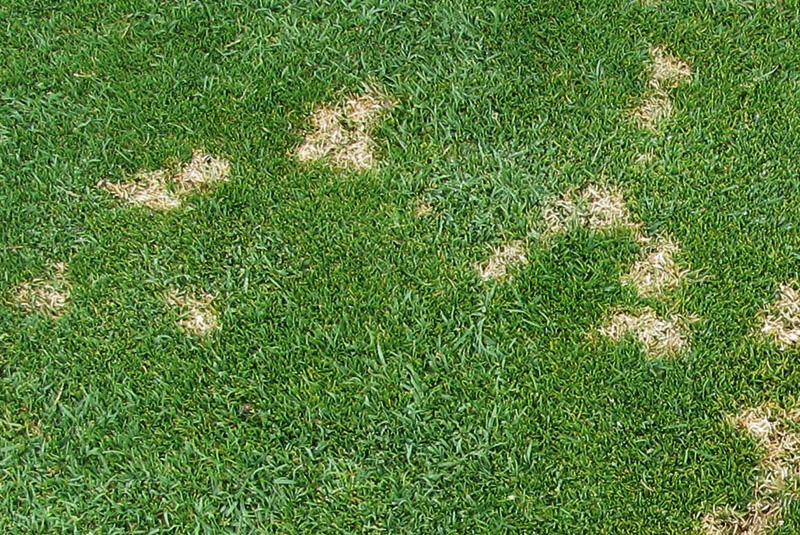Each summer, a number of turf diseases emerge and wreak havoc on lawns. There are a couple of diseases that are most common, especially in the South. That’s why we’ve connected with Greg Johnson, our Southeast Turf & Agronomic Manager, to get his recommendations on the best way to handle these turf diseases this summer.
From Greg Johnson:
Identifying Brown Patch / Large Patch Disease
The most common turf grass disease in the South is Brown Patch/Large Patch—and it can affect all turf grass species. Brown Patch is caused by a specific species of fungus called Rhizoctonia. This fungus creates large, inconsistent patches of straw-colored, dead grass throughout the lawn. Another telltale sign of Rhizoctonia is a white, web-like mycelium that looks similar to a spider’s web. You will typically notice this in the early morning before the dew has fully evaporated.
Not to fear, these fibers are not caused by an army of spiders taking over your yard. They are a network of long vegetative fibers called hyphae and mass fungal spores that help the fungus reproduce and spread. You’ll typically see this web-like mycelium in late summer with the climate is very humid and hot. Rhizoctonia can also survive over winter beneath the ground, reviving itself in the spring when new grass blades emerge.
What to Do Next – Brown Patch
The good news is you can control and even prevent Brown Patch. The easiest way to do this is to avoid high nitrogen rates. Products like Hudson Valley Natural’s fertilizers, including Jackpot is an excellent choice to use starting in the spring to minimize the chances of Brown Patch.
Other prevention methods include following good lawn care practices:
- Mow at least once a week
- Keep your turfgrass watered properly
- Long infrequent waterings are the best
- Water early in the morning when the turf would be naturally wet from dew
Once Brown Patch/Large Patch has established, you can use a fungicide control method to treat it. I recommend an azoxystrobin fungicide like Armada or Strobe 50WG. Azoxystrobin fungicides will normally last about 21-28 days from application.
It is important to re-applicate around 21-24 days with a different non-azoxystrobin product, this is so Rhizoctonia does not build a resistance to the fungicide. I recommend, thiophanate methyl (T-METHYL 4.5F) for your second application. Remember, fungicides only arrest fungus pathogens they do not cure them. In some circumstances, it is possible for some warm-season turf to almost recover from this disease completely, but it is not guaranteed.
Identifying Dollar Spot
Another very common summer turfgrass disease is Dollar Spot. You will notice this looks like a looks like a series of small, silver dollar sized patches of yellow grass. Zoysia and fescue grasses are particularly vulnerable to Dollar Spot but it can affect a large variety of both cool-season and warm season grasses.
What to Do Next – Dollar Spot
Dollar Spot can spread hastily (and inadvertently) on property that is lacking enough nutrients to the grass roots, if the lawn is often left too wet, or if it is mowed too often and too short. It’s important to make sure the lawn is fed with quality nutrients, overwatering is avoided, and that mower blades are raised three or four inches higher.
Remember
Rely on the experts at Central to help you with any of your turfgrass questions. We stay at the leading-edge of the industry. We have experts on staff at all our local branches and they’re ready to help you grow your business. Thank you!
About Greg Johnson
Greg has 25 years in the Green Industry and started out treating lawn, and tree and shrubs while attending college. Through hard work, and dedication Greg opened up two successful businesses in the Atlanta area that focused on tree/ shrub, lawn-care, and mosquito control. After growing these businesses successfully, Greg joined the Central team in 2019. Throughout his career Greg has strived for excellence, receiving numerous awards in sales, Employee of the Year, and Branch Manager of the Year. Greg also holds a Category 24 and 41 License with the Georgia Department of Agriculture. Greg is a member of the Urban Agg Council and works with University of Georgia training licensed applicators. Greg is ready to help you take your turf and ornamental category to the next level.

